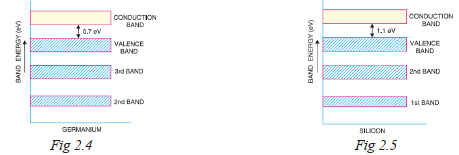- It has already been discussed that a semiconductor is a substance whose resistivity lies between conductors and insulators. The resistivity is of the order of 10
-4 to 0.5 ohm metre. However, a semiconductor can be defined much more comprehensively on the basis of energy bands as under :

- A semiconductor is a substance which has almost filled valence band and nearly empty conduction band with a very small energy gap ( ˜ 1 eV) separating the two.
- Figs. 2.4 and 2.5 show the energy band diagrams of germanium and silicon respectively. It may be seen that forbidden energy gap is very small; being 1.1 eV for silicon and 0.7 eV for germanium. Therefore, relatively small energy is needed by their valence electrons to cross over to the conduction band. Even at room temperature, some of the valence electrons may acquire sufficient energy to enter into the conduction band and thus become free electrons. However, at this temperature, the number of free electrons available is very small. Therefore, at room temperature, a piece of germanium or silicon is neither a good conductor nor an insulator. For this reason, such substances are called semiconductors.
- The energy band description is extremely helpful in understanding the current flow through a semiconductor.
Wilfykil answered the question on
August 13, 2019 at 12:25